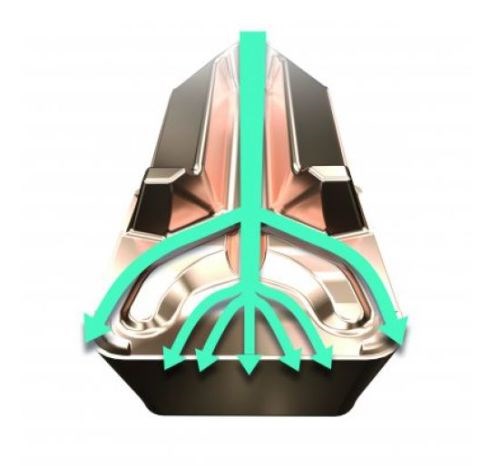Making the Cut
As this short case study illustrates, Kennametal’s grooving and cutoff tools provide more precise chip control and extended tool life.

Recent years have seen the development of multipurpose cutoff tools that are able to perform as grooving, turning and profiling tools, giving manufacturers the ability to simplify setups and shorten production cycles.
From hand-ground bits to high-speed steel blades to indexable carbide inserts, cutoff tool technology has continued to improve over the years, increasing metalcutting efficiency and lowering operational expenses. A big step in that evolution came with the development in recent years of multipurpose cutoff tools that are able to perform as grooving, turning and profiling tools, giving manufacturers the ability to simplify setups and shorten production cycles, and in some cases, keep fewer tools in the crib.
A case in point is EMC Precision, a precision machining job shop headquartered in Elyria, Ohio. Since 1925, the company has provided prototype to production machining and value-added services to a range of industries including fluid management, hydraulic fluid and power, automotive, recreational, and other OEMs. Ian Dotson, manufacturing engineer at EMC’s facility in Sheridan, Indiana, says he was happy with the tool life and performance of his existing cutoff solution, and was only looking for a reduction in his tooling costs when he called his local Kennametal distributor. It was then he learned about Kennametal’s Beyond Evolution, a single-sided grooving and cutoff system with multidirectional turning capability, through-tool coolant, chip control, and “Triple V” secure seating geometry.
“We were using a 0.118-inch wide PVD-coated insert to cut off 0.75-inch diameter 4140 steel hydraulic actuators,” he says. “We swapped out the old tool for a Kennametal Beyond Evolution cutoff and kept the feeds and speeds the same. After several runs we determined tool life was essentially identical, so from a performance perspective there was no difference, at least not on this job. But the Beyond Evolution inserts are dramatically less expensive, roughly 40 percent of what we were paying for our legacy tools, so it was a clear win for us.”
The next win came on a job Mr. Dotson was running on one of EMC’s CNC lathes; a transmission gear shaft made of 1-1/4 inch 8620 steel and using a 0.236-inch wide tool to back turn a journal on the left side of the part prior to cutoff. In this application, insert cost was still a concern, but Dotson’s primary goal was tool life improvement.
“The lathe isn’t equipped with high pressure cutting fluid, and the standard pump was unable to generate enough pressure for us to utilize coolant through the tool on our old cutoff system,” he explains. “Because of this, we’ve been stuck with flood coolant, and have always had some chip control issues as a result—the chip would roll back on itself and starve the cutting edge of coolant.”
Despite the less than optimal cutting conditions, the Beyond Evolution performed beyond expectations. “We achieved very good results,” Mr. Dotson says. “This time, we increased the cutting speed a bit, from 350 to 400 sfm, and bumped up the feed rates by about 30 percent. Even so, tool life increased threefold, to just over 2,600 pieces per insert. I’m confident we could have cranked up the feeds and speeds even more, especially if we had plumbed the tool for coolant through, but there was no need. This operation supplies another machine, and that one was already running as fast as it could go. The big thing for us was getting more parts between tool changes, and that’s exactly what the Beyond Evolution did.”

Specially designed coolant delivery channels in the Beyond Evolution system separate and direct cutting fluid to where it’s needed most: underneath the chip and into the work area.
RELATED CONTENT
-
4 Strategies for Managing Chip Control
Having strategies in place for managing chips is an important part of protecting the production process, from tool life to product quality.
-
When Thread Milling Makes Sense
Threading a workpiece is a fundamental metalworking process that every manufacturing engineer takes for granted.
-
Calculating Surface Footage and RPM for Optimum Tool Life
Tech Brief: Calculating Surface Footage and RPM for Optimum Tool Life


